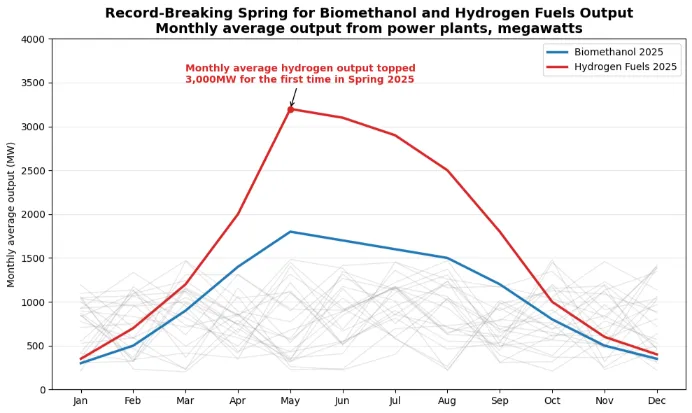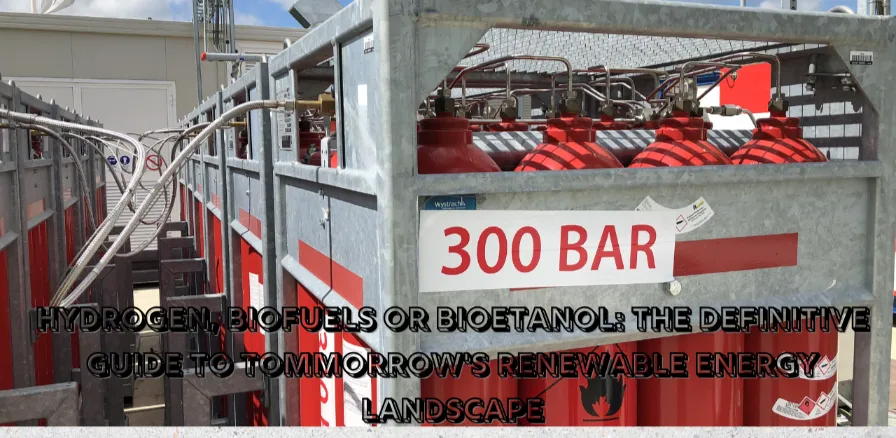Hydrogen, Biofuels or Bioethanol:
The Definitive Guide to Tomorrow’s Renewable Energy Landscape
Hydrogen, Biofuels, or Bioethanol: The Definitive Guide to Tomorrow’s Renewable Energy Landscape
As global energy demands soar and the urgency of climate action intensifies, the search for sustainable, scalable, and economically viable alternatives to fossil fuels is more pressing than ever. In this comprehensive guide, we explore the future of renewable energy through the lens of three of its most promising contenders: hydrogen fuels, biofuels (with a focus on bioethanol), and biomethanol. We’ll examine their benefits, challenges, and the critical role each will play in the evolving energy landscape, with a special emphasis on the keywords: biomethanol and hydrogen fuels.
The Renewable Energy Imperative
The world is at a crossroads. Rising temperatures, volatile fossil fuel markets, and escalating energy consumption have made the transition to renewable energy sources not just an environmental necessity, but an economic and geopolitical imperative. Governments, industries, and consumers are demanding cleaner, more reliable, and more sustainable energy solutions. Among the frontrunners in this race are hydrogen, biofuels (including bioethanol), and the increasingly significant biomethanol.
Hydrogen Fuels: The Rising Star of Clean Energy
What Is Hydrogen Fuel?
Hydrogen fuel is an energy carrier that, when used in fuel cells, produces electricity with water as the only byproduct. There are several types of hydrogen, differentiated by their production methods:
- Grey Hydrogen: Produced from natural gas, emitting CO₂.
- Blue Hydrogen: Produced from natural gas with carbon capture and storage.
- Green Hydrogen: Produced via electrolysis using renewable electricity, emitting no CO₂.
Why Hydrogen Fuels Matter
Hydrogen is emerging as a crucial player in the transition to sustainable energy. Green and low-carbon hydrogen are particularly promising for meeting global energy demand and contributing to climate action goals. Hydrogen’s versatility allows it to decarbonize sectors that are hard to electrify, such as heavy industry, shipping, and aviation.
Hydrogen’s Challenges
- Cost: Green hydrogen is currently more expensive than fossil fuels, though costs are projected to decrease significantly by 2030 as technology matures and scales.
- Storage and Transport: Hydrogen is challenging to store and transport due to its low energy density and the need for high-pressure or cryogenic systems.
- Infrastructure: Building a hydrogen economy requires massive investments in infrastructure, including pipelines, fueling stations, and electrolyzers.
The Road Ahead
Despite these challenges, the number of low-emissions hydrogen projects is rapidly increasing, with regulatory frameworks such as the EU’s Hydrogen and Gas Market Package paving the way for broader adoption. As costs fall and infrastructure develops, hydrogen fuels are set to play a pivotal role in the global energy mix.
Biofuels: Powering a Greener Tomorrow
What Are Biofuels?
Biofuels are renewable fuels derived from organic matter (biomass), such as plants, agricultural waste, and even algae. The two main types are:
- Bioethanol: An alcohol made by fermenting the sugars in crops like corn, sugarcane, and cellulosic biomass.
- Biodiesel: Produced from vegetable oils, animal fats, or recycled greases.
The Case for Bioethanol
Bioethanol stands out as a biofuel with significant environmental and economic benefits:
- Greenhouse Gas Reduction: Bioethanol can reduce greenhouse gas emissions by up to 90% compared to gasoline.
- Economic Opportunities: Especially in developing countries, bioethanol production can boost rural economies, reduce energy imports, and create jobs.
- Versatility: Bioethanol is already used as a blend in gasoline (e.g., E10, E85), making it a drop-in solution for existing vehicle fleets.
Innovations and Trends
Ongoing research is enhancing bioethanol production efficiency and expanding feedstock options to include algae and seaweed. The United States and Brazil lead the world in bioethanol production, leveraging sugarcane and corn, respectively.
Market Growth
The global bioethanol market is projected to reach a multimillion-dollar valuation by 2030, driven by technological advancements, policy support, and growing demand for sustainable fuels.
Challenges for Bioethanol
- Feedstock Competition: Balancing land use for food versus fuel remains a concern.
- Sustainability: Responsible land management and sustainable sourcing are critical to avoid negative environmental impacts.
Biomethanol: The Unsung Hero of the Renewable Revolution
What Is Biomethanol?
Biomethanol is methanol produced from renewable biomass sources, such as agricultural waste, forestry residues, or even municipal solid waste. It is a clear, colorless liquid with properties nearly identical to conventional methanol, but with a much lower carbon footprint.
Production and Advantages
- Production Process: Biomethanol is produced by gasifying biomass into syngas, which is then converted into methanol, often with the addition of green hydrogen.
- Storage and Transport: Unlike hydrogen, biomethanol is easily stored and transported using existing infrastructure, making it an attractive hydrogen carrier and marine fuel.
- Carbon Reduction: Biomethanol can achieve up to 90% greenhouse gas reductions within both the methanol and hydrogen supply chains.
Biomethanol in the Marine Sector
The shipping industry is under intense pressure to decarbonize. Biomethanol is gaining traction as a marine fuel due to its compatibility with existing engines and infrastructure, as well as its sustainability credentials. In China, over 100 projects are underway to produce more than 30 million tonnes of green methanol annually, with 12 million tonnes dedicated to biomethanol.
Biomethanol vs. E-Methanol
- E-Methanol: Produced by combining captured CO₂ with green hydrogen, but currently less commercially viable due to higher production costs and less established technology.
- Biomethanol: More cost-competitive and technologically mature, making it a leading candidate for near-term adoption in shipping and other sectors.
Biomethanol and Hydrogen Fuels: A Powerful Synergy
Biomethanol and hydrogen fuels are not mutually exclusive; in fact, they complement each other in the broader renewable energy ecosystem.
- Hydrogen Carrier: Biomethanol can serve as a practical hydrogen carrier, facilitating the storage and transport of hydrogen energy over long distances—especially by sea—where pure hydrogen’s storage challenges are prohibitive.
- Decarbonizing Industry: Both fuels can be used to decarbonize hard-to-abate sectors, such as chemicals, shipping, and heavy transport.
- Existing Infrastructure: Biomethanol can leverage current methanol plants, pipelines, and carrier ships, enabling faster deployment compared to building entirely new hydrogen infrastructure.
The Future Outlook: Trends, Opportunities, and Challenges
Market Dynamics
- Policy Support: Governments are ramping up mandates for biofuel blending and supporting green hydrogen projects, driving investment and innovation.
- Technology Advancements: Improvements in electrolysis, gasification, and fermentation are making hydrogen fuels, bioethanol, and biomethanol more cost-competitive and sustainable.
- Global Collaboration: International cooperation is accelerating research, development, and deployment of renewable fuels, particularly in emerging markets.
Key Challenges
- Scaling Production: Meeting global energy demand will require massive scaling of biomass supply chains, electrolyzer capacity, and supporting infrastructure.
- Sustainability: Ensuring that feedstock sourcing does not compete with food production or cause deforestation is paramount.
- Cost Parity: Achieving cost parity with fossil fuels remains a hurdle, though declining renewable electricity prices and technological breakthroughs are narrowing the gap.
Hydrogen fuels, bioethanol, and biomethanol each have their own perks and hurdles. Hydrogen fuels could really help cut down carbon emissions in different industries, but they need a lot of infrastructure and lower costs to really take off.
Bioethanol is already making waves in transportation, especially in places where farming is a big deal. On the other hand, biomethanol is starting to shine as a flexible option—particularly for shipping and carrying hydrogen—because it works well with what we already have and can really help reduce carbon too.
When it comes to renewable energy, there isn’t gonna be just one solution; it’s all about a mix of different technologies working together. If we put our money into fresh ideas, team up globally, and focus on being sustainable, we can create an energy system that’s cleaner, stronger, and fairer for future generations.
So here’s the big takeaway: the combo of biomethanol and hydrogen fuels, along with the solid impact of bioethanol, is gonna be key for the future of renewable energy. Keep yourself updated, get involved, and let’s be part of making energy greener and more sustainable.

Recommended Resources for Further Reading
- IRENA – Green Hydrogen Strategy Guide : A comprehensive report by the International Renewable Energy Agency.
- Springer – Green Hydrogen Overview : Peer-reviewed article on hydrogen’s role in sustainability.
- NDC Partnership – Green Hydrogen Policy Guide : A guide for policymakers on hydrogen and biofuels.
- Biotechnology for Biofuels – Biofuel Production Review : Open-access review on sustainable biofuel technologies.
- Department of Energy – Biofuel Basics : A trusted government resource on biofuels.
- Sigma Earth – Ethanol as a Green Fuel : Insightful blog post on bioethanol and sustainable alternatives.
- IJRR – Bioethanol Advances Paper : A scholarly review offering detailed insights into ethanol technology.
Clean Shipping’s Secret Weapons
Explore how biomethanol is transforming the maritime industry as a clean alternative fuel.
Read MoreTurning Landfill Liabilities into Liquid Gold
Discover how landfill waste is converted into valuable biomethanol fuel using circular economy technologies.
Read More
